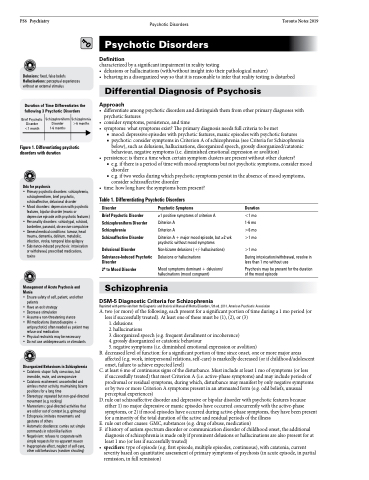Page 1170 - TNFlipTest
P. 1170
PS6 Psychiatry
Psychotic Disorders
Toronto Notes 2019
Delusions: fixed, false beliefs Hallucinations: perceptual experiences without an external stimulus
Duration of Time Differentiates the following 3 Psychotic Disorders
Psychotic Disorders
Definition
characterized by a significant impairment in reality testing
• delusionsorhallucinations(with/withoutinsightintotheirpathologicalnature)
• behavinginadisorganizedwaysothatitisreasonabletoinferthatrealitytestingisdisturbed
Differential Diagnosis of Psychosis
Approach
• differentiate among psychotic disorders and distinguish them from other primary diagnoses with psychotic features
• considersymptoms,persistence,andtime
• symptoms: what symptoms exist? The primary diagnosis needs full criteria to be met
■ mood: depressive episodes with psychotic features, manic episodes with psychotic features
■ psychotic: consider symptoms in Criterion A of schizophrenia (see Criteria for Schizophrenia below), such as delusions, hallucinations, disorganized speech, grossly disorganized/catatonic
behaviour, negative symptoms (i.e. diminished emotional expression or avolition)
• persistence:isthereatimewhencertainsymptomclustersarepresentwithoutotherclusters?
■ e.g. if there is a period of time with mood symptoms but not psychotic symptoms, consider mood disorder
■ e.g. if two weeks during which psychotic symptoms persist in the absence of mood symptoms, consider schizoaffective disorder
Brief Psychotic Disorder <1 month
Schizophreniform Schizophrenia
Disorder 1-6 months
>6 months
Figure 1. Differentiating psychotic disorders with duration
Ddx for psychosis
• Primary psychotic disorders: schizophrenia, schizophreniform, brief psychotic, schizoaffective, delusional disorder
• Mood disorders: depression with psychotic features, bipolar disorder (manic or depressive episode with psychotic features)
• Personality disorders: schizotypal, schizoid, borderline, paranoid, obsessive-compulsive
• General medical conditions: tumour, head trauma, dementia, delirium, metabolic, infection, stroke, temporal lobe epilepsy
• Substance-induced psychosis: intoxication or withdrawal, prescribed medications, toxins
Management of Acute Psychosis and Mania
• Ensure safety of self, patient, and other
patients
• Have an exit strategy
• Decrease stimulation
• Assume a non-threatening stance
• IM medications (benzodiazepine +
antipsychotic) often needed as patient may
refuse oral medication
• Physical restraints may be necessary
• Do not use antidepressants or stimulants
Disorganized Behaviours in Schizophrenia
• Catatonic stupor: fully conscious, but immobile, mute, and unresponsive
• Catatonic excitement: uncontrolled and aimless motor activity, maintaining bizarre positions for a long time
• Stereotypy: repeated but non-goal-directed movement (e.g. rocking)
• Mannerisms: goal-directed activities that are odd or out of context (e.g. grimacing)
• Echopraxia: imitates movements and gestures of others
• Automatic obedience: carries out simple commands in robot-like fashion
• Negativism: refuses to cooperate with simple requests for no apparent reason
• Inappropriate affect, neglect of self-care, other odd behaviours (random shouting)
• time:howlonghavethesymptomsbeenpresent?
Table 1. Differentiating Psychotic Disorders
Disorder
Brief Psychotic Disorder Schizophreniform Disorder Schizophrenia Schizoaffective Disorder
Delusional Disorder
Substance-Induced Psychotic Disorder
2o to Mood Disorder
Psychotic Symptoms
≥1 positive symptoms of criterion A
Criterion A
Criterion A
Criterion A + major mood episode, but ≥2 wk psychotic without mood symptoms
Non-bizarre delusions (+/- hallucinations) Delusions or hallucinations
Mood symptoms dominant + delusions/ hallucinations (mood congruent)
Duration
<1 mo 1-6 mo >6 mo >1 mo
>1 mo
During intoxication/withdrawal, resolve in less than 1 mo without use
Psychosis may be present for the duration of the mood episode
Schizophrenia
DSM-5 Diagnostic Criteria for Schizophrenia
Reprinted with permission from the Diagnostic and Statistical Manual of Mental Disorders, 5th ed. 2013. American Psychiatric Association
A. two (or more) of the following, each present for a significant portion of time during a 1 mo period (or less if successfully treated). At least one of these must be (1), (2), or (3)
1. delusions
2. hallucinations
3. disorganized speech (e.g. frequent derailment or incoherence)
4. grossly disorganized or catatonic behaviour
5. negative symptoms (i.e. diminished emotional expression or avolition)
B. decreased level of function: for a significant portion of time since onset, one or more major areas affected (e.g. work, interpersonal relations, self-care) is markedly decreased (or if childhood/adolescent onset, failure to achieve expected level)
C. at least 6 mo of continuous signs of the disturbance. Must include at least 1 mo of symptoms (or less
if successfully treated) that meet Criterion A (i.e. active-phase symptoms) and may include periods of prodromal or residual symptoms, during which, disturbance may manifest by only negative symptoms or by two or more Criterion A symptoms present in an attenuated form (e.g. odd beliefs, unusual perceptual experiences)
D. rule out schizoaffective disorder and depressive or bipolar disorder with psychotic features because either 1) no major depressive or manic episodes have occurred concurrently with the active-phase symptoms, or 2) if mood episodes have occurred during active-phase symptoms, they have been present for a minority of the total duration of the active and residual periods of the illness
E. rule out other causes: GMC, substances (e.g. drug of abuse, medication)
F. if history of autism spectrum disorder or communication disorder of childhood onset, the additional
diagnosis of schizophrenia is made only if prominent delusions or hallucinations are also present for at
least 1 mo (or less if successfully treated)
• specifiers:typeofepisode(e.g.firstepisode,multipleepisodes,continuous),withcatatonia,current
severity based on quantitative assessment of primary symptoms of psychosis (in acute episode, in partial remission, in full remission)


